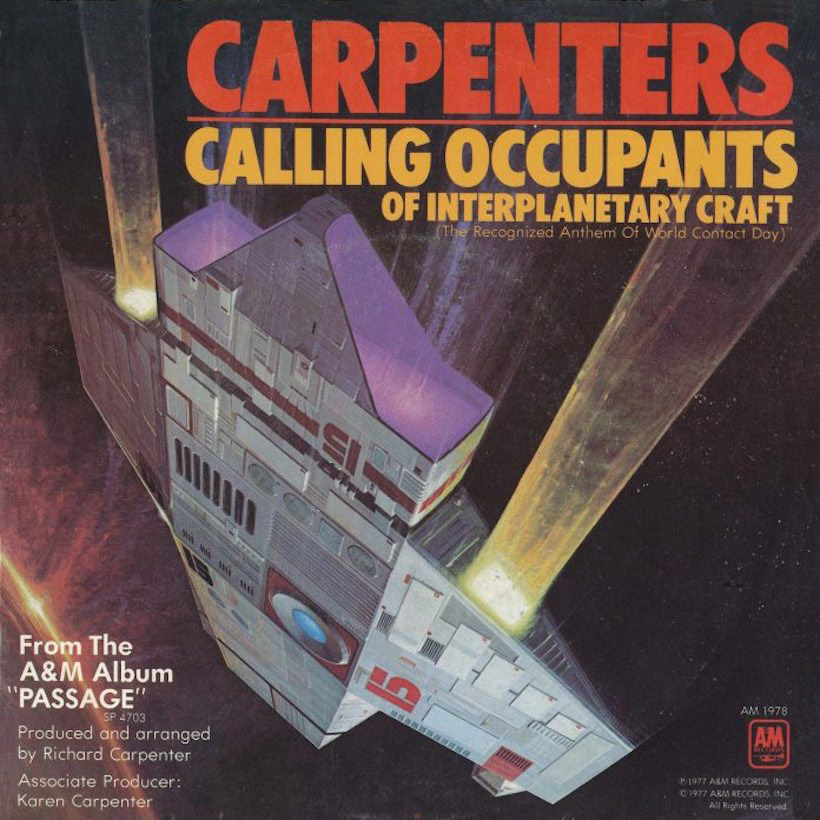Have you heard the one about the futuristic track by a group that were rumored to be The Beatles in disguise, and which was turned into a hit by America’s favorite musical brother and sister?
This is the story of how the Carpenters get involved with an organization called the International Flying Saucer Bureau, and turned the affair into a hit record. Devotees of quality pop of the 1970s will, by now, know that we’re talking about “Calling Occupants Of Interplanetary Craft,” which in 1977 became Karen and Richard’s last UK Top 10 hit.
But the song had debuted a year earlier, amid a degree of orchestrated hype surrounding its somewhat Beatlesque sound. Could this, and its Capitol Records parent album 3:47 EST, actually be the results of a secret reunion by the Fab Four?
The tale began in 1953, when the aforesaid International Flying Saucer Bureau sent a bulletin to its members encouraging them to join the first World Contact Day. Members were urged, at a specific time on a given day, to send out a collective telepathic message to visitors from outer space. The message began with the words…you guessed, “Calling occupants of interplanetary craft.”
In 1967, Jay David published a book called The Flying Saucer Reader, which was picked up by John Woloschuk, one of the founding members of a Canadian group named Klaatu. It had an enormous effect on him. The Canadian progressive rock trio formed in 1973 in Toronto and had some local success, notably with the RPM Top 40 chart hit “California Jam” the following year.
The sci-fi-fueled group, formed by Woloschuk and Dee Long, were named after an alien character in the classic 1951 movie The Day the Earth Stood Still. Indeed, 3:47 EST was the time that the interplanetary visitor arrived in Washington, D.C. in the film.
Drummer Terry Draper joined a couple of singles into the Klaatu story, and it was he and Woloschuk that wrote the song, produced by Draper, that would give them a moment in the world’s spotlight. Capitol fanned the flames of the Beatle rumors, neither confirming nor denying them, amplifying interest in “Calling Occupants Of Interplanetary Craft” and helping it to a No.62 peak on the Billboard Hot 100. The parent album, simply named after the group for its US release, reached No.32, deliberately eschewing musician credits for extra inscrutability.
Beatles, Badfinger, Beach Boys
Beatle devotees will note that the LP often sounds more like a cross between their Apple acolytes Badfinger and the Beach Boys, sometimes with a little 10cc thrown in. Casting further doubt on the spurious rumors, it might be added that the penultimate “Sir Bodsworth Rugglesby III” might have been a novelty from a Muppet Show.
While making their second album in London, Klaatu’s alleged identity was mocked in a New Musical Express article, after which the group’s real names were uncovered by WWDC Washington program director Dwight Douglas. They went on to release that sophomore album, Hope, in 1977 and three more, Sir Army Suit (1978), Endangered Species (1980), and 1981’s Magentalane.
The Carpenters heard the 1976 single, and looked to create their own version of “Calling Occupants.” It came out on September 20, 1977, having been recorded for their album Passage, and entered the Hot 100 on October 8, as the week’s highest new entry. The Carpenters rely heavily on the original Klaatu arrangement, but the duo’s version is very different for the first minute of the song, which Richard arranged as a spoof phone-in to a radio station DJ, played by the band’s longtime guitarist Tony Peluso.
Peluso says hello to “Mike Ledgerwood,” but the voice that responds is that of an alien trying to make contact on “World Contact Day.” Ledgerwood was an executive at the UK offices of the Carpenters’ record label, A&M Records who had also been deputy editor of the British pop paper Disc & Music Echo.
The Carpenters version was recorded on the A&M sound stage in Los Angeles and featured the Los Angeles Philharmonic Orchestra, who for contractual reasons was referred to as the “Overbudget Philharmonic,” along with a large choir. The orchestral arrangements were by British arranger and conductor Peter Knight whose credits include the Moody Blues’ Days of Future Passed album. Other musicians include Ronnie Tutt, a member of Elvis Presley’s band for many years.
Listen to the best of the Carpenters on Apple Music and Spotify.
The track climbed no higher than No.32 in the US, but made No.9 on the UK singles chart to become the Carpenters’ final visit to the singles Top 10 there. The cover art featured on the US single was painted by Star Trek designer, Andrew Probert, and the subtitle, The Recognized Anthem Of World Contact Day, referred to the mission launched in 1953 to send a telepathic message into space by – of course – the International Flying Saucer Bureau.
Buy or stream the Carpenters’ Passage.




